南宁园博园采石场花园
Quarry Gardens in Nanning Garden Expo Park
-
项目地点:广西南宁
项目业主:南宁市林业和园林管理局
面积:35ha
设计时间:2016-2017年
建成时间:2018
获奖:2019年英国国家景观协会(BALI)国家景观奖
2019中国风景园林学会科学技术奖规划设计一等奖
2020年美国风景园林师协会(ASLA)综合设计奖
2021英国皇家风景园林学会(LI)景观设计类大奖
2021世界建筑节(WAF)自然环境景观类入围奖
2021北京市优秀工程勘察设计奖园林景观综合奖一等奖
2022国际风景园林师联合会亚非中东地区(IFLA AAPEM)经济可行类类荣誉奖
2023中国风景园林学会科学技术奖(科技进步奖)一等奖
-
Project location:Nanning, Guanxi Province
Clients:Nanning forestry and Landscape Management Bureau
Area:35ha
Design year:2016-2017
Year Built: 2018
Awards:2019 BALI National Landscape Award
2019 CHSLA Planning & Design Award(1st Prize)
2020 ASLA Professional Award
2021 LI Landscape Design (Winner Award)
2021 WAF Nature Context-Landscape(Shortlist)
2021 Outstanding Engineering & Consulting Project Award(1st Prize)
2022: IFLA AAPEM Award in Economic Viability(Honorable Mention)
2023 CHSLA Science and Technology Award(1st Prize,Technological Progress)
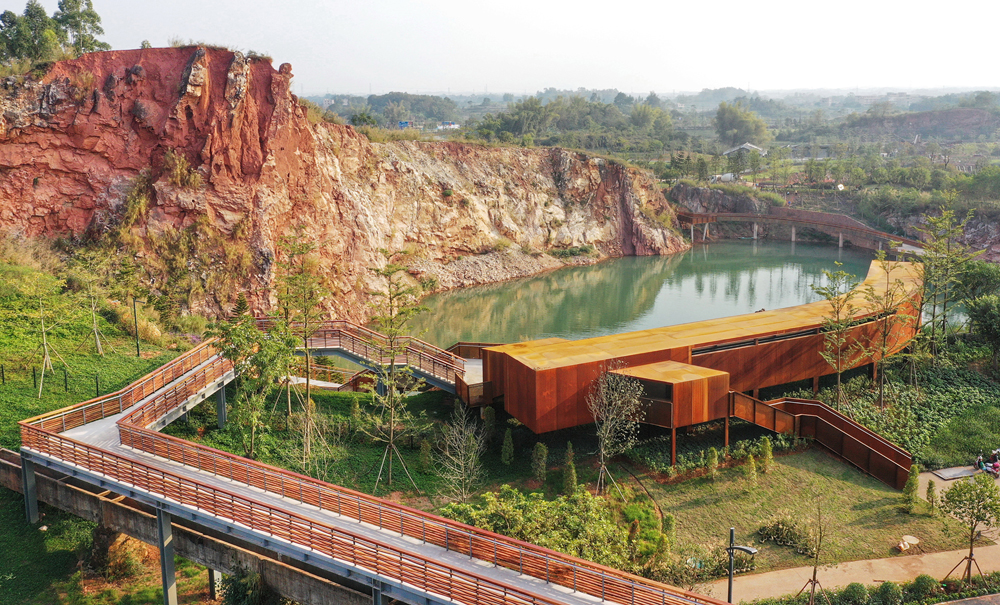
2018年中国国际园林博览会在南宁市举办。园博园选址于城市郊区的一片滨河的丘陵农业区,但场地东南区域分布着一系列的采石场。组委会希望将这些采石场转变为园林博览会中的有特色的园林,成为展览的一部分。
2018 China International Garden Expo was held in Nanning, positioned along a river in the city’s hilly outskirts. Interspersed in the southeast section of the site is a series of quarries. The organizing committee hoped to transform seven of the relatively intact quarries into distinctive gardens displaying in the garden expo.
设计面积约33公顷。场地上共7个采石场,有的已停采了几年,有2个直到园博会申办成功时才停止开采。由于开采采用的是爆破方式,因此开采面崖壁破碎,坑底高低不平。采石场留下的是破碎的丘陵,高耸的悬崖,荒芜的地表,深不见底的水潭,成堆的渣土渣石,和生锈的采石设备。
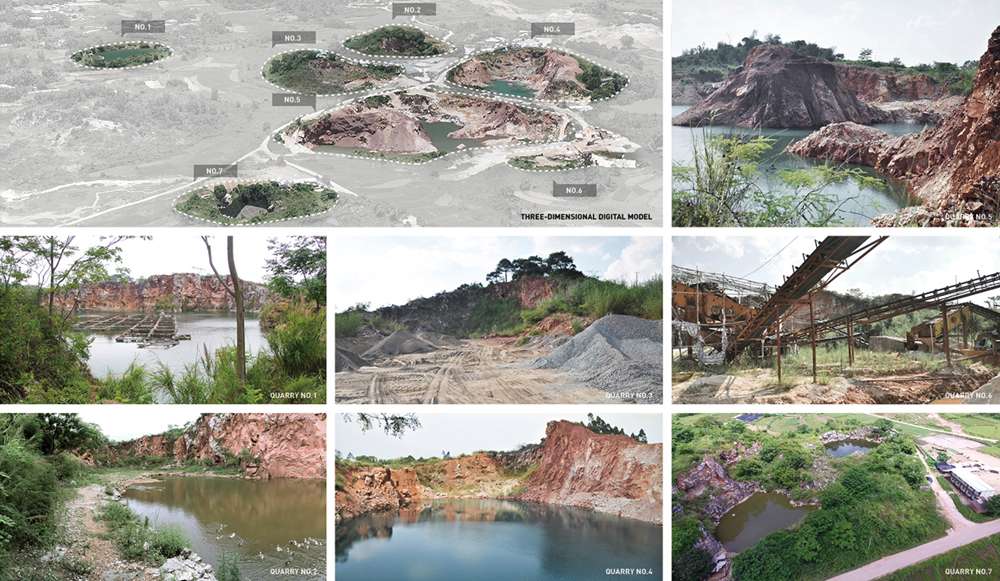
设计面临着一系列巨大的挑战:采石场地质情况复杂,岩壁破碎,有崩塌落石的可能,有不可预知的安全隐患;采石场生态环境破坏严重,植被的修复面临很大挑战;采石坑的地貌极其复杂,无法依据现状测绘图纸进行设计;采石坑的水位一直在变化,尤其是最后停采的2个采石场,水位一直在持续上升。设计没有有效的水文数据。
为了精确地开展设计,设计师通过无人机航拍扫描,得到所有采石场的三维数字模型,设计得以从始至终在三维空间上进行。设计师还委托当地机构每半个月记录一次每个坑中水位变化的情况,为设计提供依据。同时,设计师根据不同采石场植被恢复的目标,引入土壤,形成不同土壤厚度的种植区域,为恢复生境创造条。在设置设施和参观路径的时候将安全性放在首位,在突出采石场景观特色的同时避让危险区域。
Through an aerial scanning of UAV, landscape architects obtained three-dimensional digital models of all quarries, on this basis the design could well match the site landforms. To provide relevant data required for the design, a local institution was assigned to record changes in the water levels of each quarry every half month. With safety as primary consideration, the setting of facilities and various paths intentionally avoid dangerous zones, while highlighting distinctive features of the quarry landscape. Moreover, safety measures were strictly implemented where necessary to prevent cliff-slide rock falls. According to the different goals of vegetation restoration, soil was introduced to earth up planting areas forming different soil thicknesses to create conditions for habitat restoration of the particularly large number of native plant species. Stones, gravels, mucks, and mining machines on the site are reasonably preserved and reused in the new landscape.
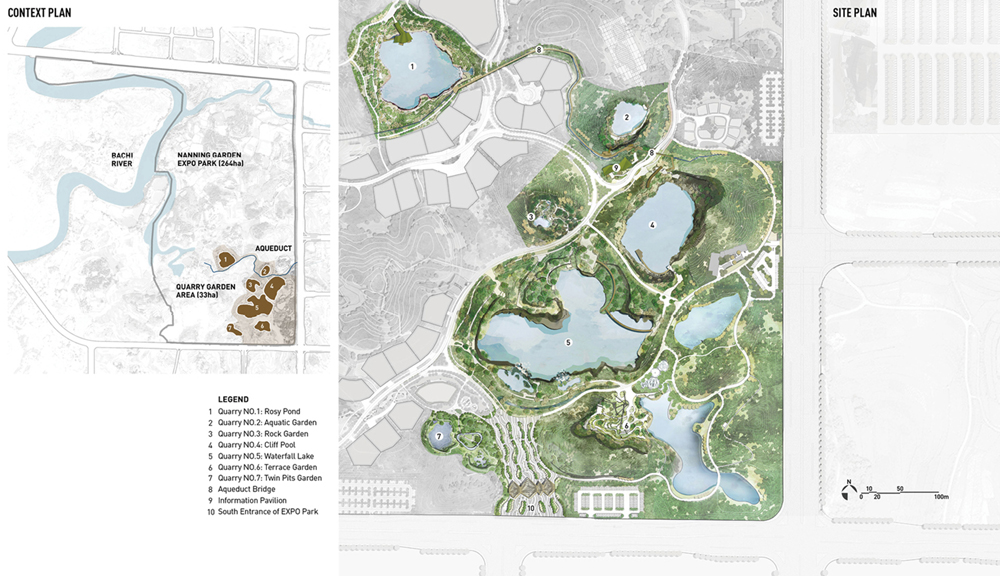
7个采石场看起来很相似,但实际上每个的尺度、形态和特征都不相同。针对不同的场地特征,设计采用了差异化的植被修复方法和人工介入方式。
Although similar in appearance, the quarries vary from each other greatly in terms of scale, space structure, and characteristics. Landscape architects adopted various methods of intervention and vegetation restoration that complement each quarry’s distinctive qualities.
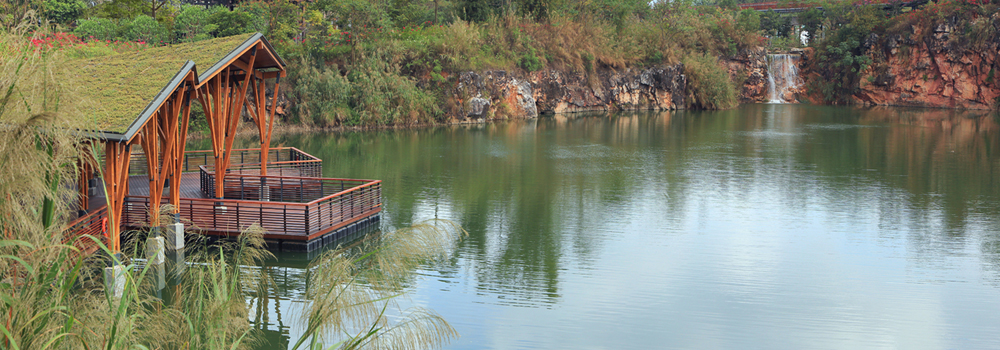
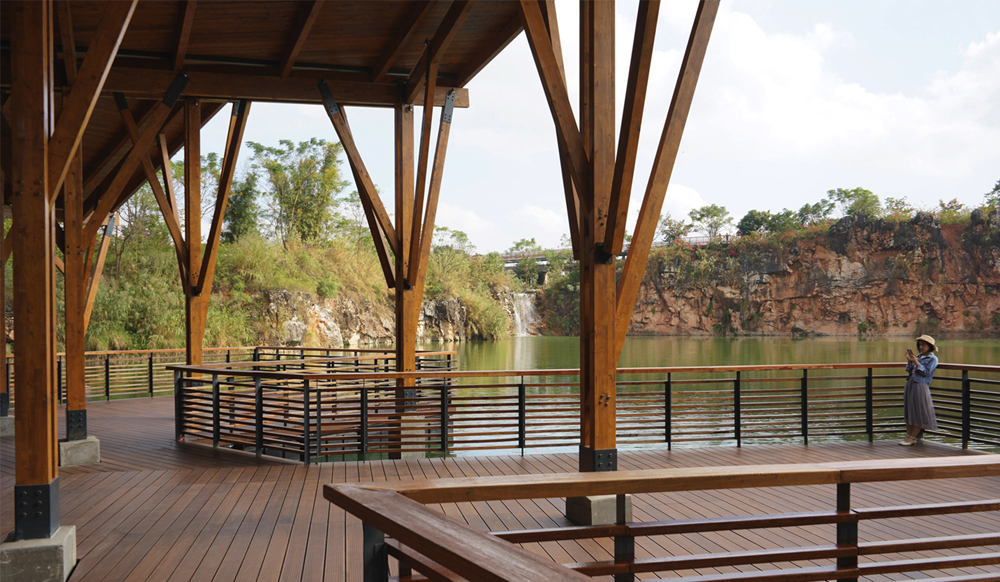
1号采石场(落霞池):
设计试图体现中国传统的风景美学。一个不规则形状的木结构建筑被嵌入池塘边缘的岩石豁口中,其结构形式从当地的乡土建筑中获得灵感。从陆地到水面,建筑从狭长的廊子转变为水边的大亭子。为适应水位的变化,亭子的地板是浮动的。游客在这里可以欣赏对面的岩壁和瀑布。瀑布为这个采石坑增加了景观的动态变化,潺潺的水声增添了宁静悠远的气氛。水岸的一条小径联系了4处不同标高的平台,为人们提供了从不同的角度观赏岩石、瀑布和建筑的场所。水边岩石上种满了红色的三角梅,悬垂下来,倒影在池塘中。
Quarry No. 1 is a one-hectare quiet pond walled within a rough rock hedge, in which China’s traditional landscape aesthetics is attempted to be embodied. A wooden and irregularly-shaped pavilion is nestled within a rock gap at the edge of a pond, whose structural form is inspired by the local vernacular architecture. It provides visitors with a panorama of green pond and encircling cliff, and babble waterfall on the diagonal opposite. To adapt to the unstable water levels, the pavilion floor is designed floated. A waterfront path links four platforms with varying elevations, offering people with all-round perspectives to enjoy the scenery.


2号采石场(水花园):
采石场面积仅为0.4 hm²,四周岩壁环绕,坑底较平缓,低处常年有积水,是周围村庄鸭子嬉戏的乐园。它被设计成为一个湿生植物花园。覆土形成的缓坡从浅水区一直延伸至岸上,种植了40多种水生和湿生植物。在地势较高处设计了两层台地,种植乔灌木,为花园创造了背景,也遮挡了破碎的岩壁。山崖上方有路径与采石坑底部连接,最高的一段是封闭的木盒,既是安全的步行通道,也是一个空中观景台,人们可在此欣赏岩壁,俯瞰花园。木盒下方有一个宽大的平台,平台引出的之字形钢格栅栈道从湿生植物种植区穿过。
Quarry No. 2 is surrounded by cliffs on all sides,with an area of only 0.4 ha. The quarry bottom is relatively flat and accumulates water perennially. The quarry is designed as an aquatic garden. The zigzag steel grating walkway winds through the planting zone and connects to a platform that further extends to a path above the cliff, accessed by several flights of steps. The section with the highest elevation features a closed wooden box, which is also an aerial viewing platform where people can appreciate a captivating view of the cliff and the entire garden expanse.
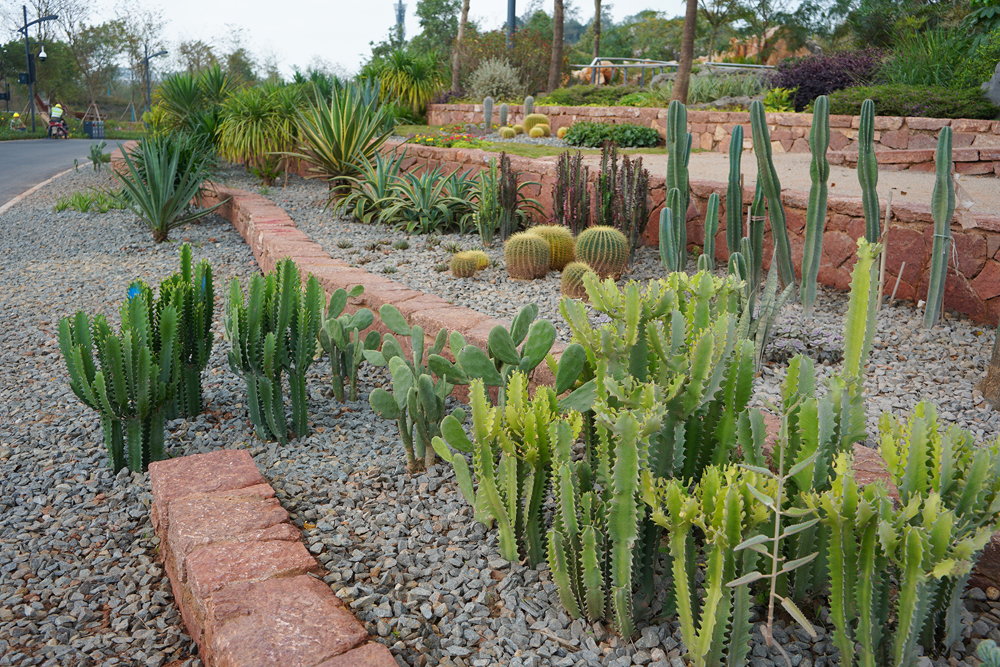

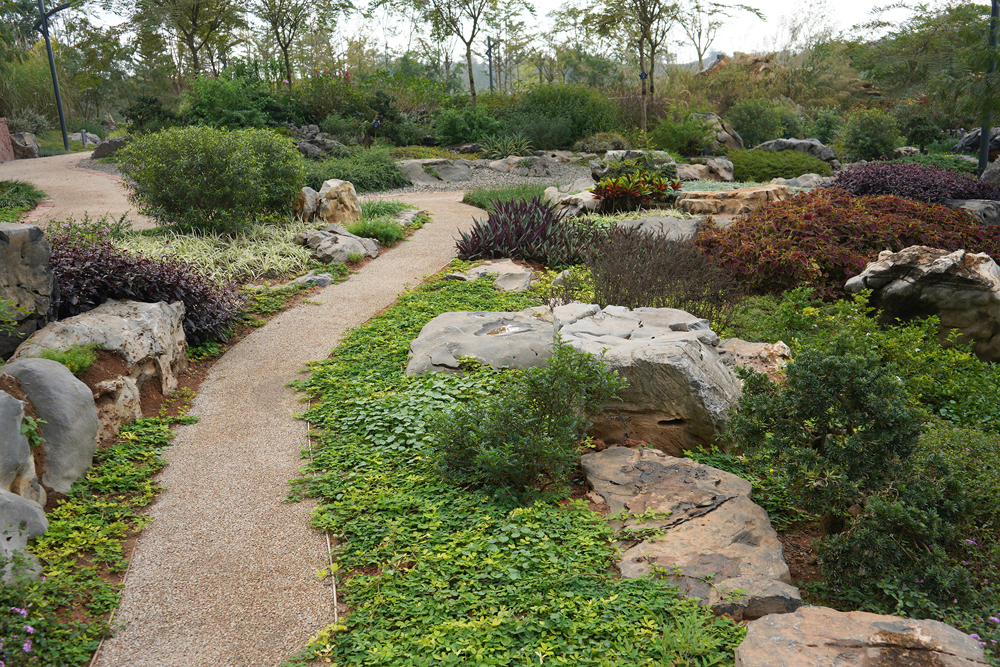

这个0.4hm²采石场基址呈碗状,三面环绕岩壁,一侧地面堆放了大量渣石和渣土。受到岩石缝隙中萌发的植物的启发,我们将这个采石场设计为精致的岩石园。设计将原有的渣石渣土整理后塑造出地形的骨架,然后在上面覆盖种植土。微妙的地形变化不仅创造出干燥和湿润等不同的生境,为不同植物生长提供条件,也把场地雨水收集到最低的凹陷区。紧邻主园路设计了几层尺度亲切、变化丰富的台地来化解高差。台地上种植了仙人掌和多肉多浆等沙生植物,营造出极富特色的沙漠植物景观。中间缓坡区展现荒原植物景观。底部凹陷区被设计为湿生岩石园,有溪流层层跌落至最低处的池塘。两个标高不同的平台位于凹陷区的边缘,人们可以凭栏观赏溪流跌水。
Quarry No. 3 is bordered by the cliff on three sides and was designed as a delicate rock garden. The abandoned soil and gravel on site were utilized as the base of the garden’s subtle landform, with planting soil wrapping its surface. A moderately-sized terrace garden is designed near the main road, creating a unique desert plant landscape. The gentle-sloping section in the center consists of a dry garden, while the southern concave section showcases hygrophilous rock plants with water cascading into the lowest pond. Two platforms with different elevations are constructed at the edge of the concave area, where people can enjoy a charming view of the garden.

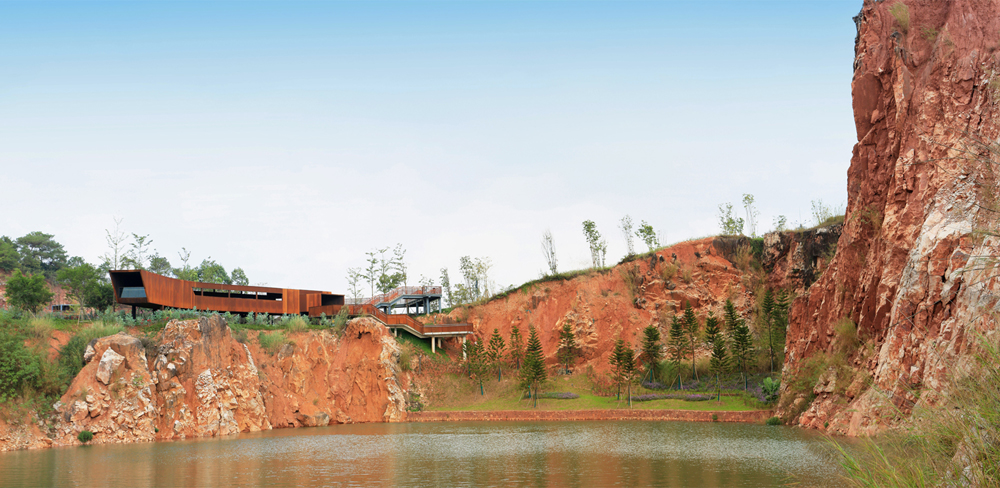

采石场停采之后渗透出来的地下水汇成一个面积约1hm²的碧绿澄澈的大水潭。我们在南北两侧主要观赏点设置了平台。北侧的观景台是一个位于采石场边缘的耐候钢长廊,内部朝向采石场打开了一长条带形窗,在此可以望见对面高出水面40多米的高耸险峻的悬崖。长廊南端悬挑在岩壁上,人们站在玻璃栏杆内侧可以俯瞰脚下的一池碧水和对面的滨水平台,惊险刺激。采石坑南侧,一个楔形平台从山石的一个豁口探出,悬挑于碧水之上,一条曲线的栈桥从平台引出,连接低处的滨水平台。坑体周围和和坑内缓坡处通过覆土,种植了南洋杉和一些乡土灌木及草本,使采石场有了生机并衬托出崖壁的险峻。
Quarry No. 4 is a large pond embraced by cliffs, with green and clear water. Viewing platforms sit on both northern and southern sides of the quarry. The northern platform is a Corten steel corridor located at the quarry’s edge, unraveling a long strip window towards the quarry, where visitors can feast their eyes on the steep cliff towering over 40 meters above the water surface. At the southern end of the corridor, people can enjoy an overlooking view of the charming pond situated beneath and the waterfront platform on the opposite side, offering a thrilling and exciting experience. On the southern side of the quarry, a wedge-shaped platform stretches out from a gap among the rocks. It hangs above the waters and connects to the lower waterfront platform through a curved bridge. Through an earthing-up process, vegetation was restored around the quarry as well as the gentle slope inside, which revives the quarry garden meanwhile highlights the steepness of cliffs.


5号采石场(飞瀑湖):
这个面积最大的采石场约3.2hm²,开采深度也最深,达28m,底部呈现几层岩台,崖壁破碎。随着地下水逐渐蓄积,水位不断上升。根据水位观测和分析,我们判断最终整个采石坑将成为一片湖面。设计师通过覆土将采石坑底部两片开采深度相对较浅的区域抬高到水面之上,并种植耐湿高大乔木如池杉和水松,形成水上丛林,为荒凉的坑体内部带来绿色和生机。然后用不同高度的栈桥引导人们进入采石坑内部,穿越水面和树林,通往岬角高处的观景台,在下降和攀登的探索中体验空间和景观的变化。为了增加景观的丰富性,栈桥对面的崖壁上设计了飞流而下的瀑布,人们可以在桥上观赏到精彩的瀑布景观。
Quarry No. 5 is the largest among the seven quarries, enclosed by dilapidated cliff with terraced rocks sitting at the bottom. The quarry has transformed into a lake, caused by the continuously-rising water level. Two areas with relatively shallow mining depths were earthed up above the water surface, and planted with trees such as pond cypress and Chinese cypress, creating an aquatic woods landscape. Bridges and walkways of varying heights crisscross above the water and through the woods, creating a connection with the hilltop view platform. A waterfall is designed on the opposite of the bridge, forming a scenery spot accordingly.

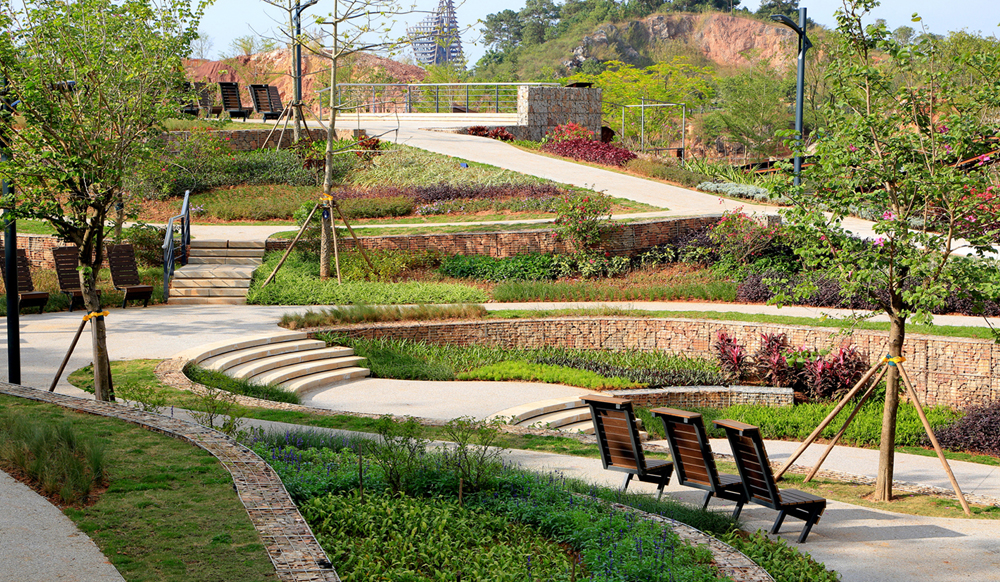
6号采石场一侧是采石场崖壁,一侧是乡村水塘,面积为0.7hm²。场地上有制砂生产线的全套设备,展现着场地采石工业的历史。它被塑造成具有后工业气氛的浪漫绚丽的花园。几层台地沿南侧崖壁蜿蜒展开,它们的覆土厚度满足不同植物生长的需要。机械设备大部分被置于绿地之中,生机勃勃的植物与锈迹斑斑的机械形成有趣的对比。道路在不同高度的台地中和原有高架传送带下方曲折穿过,路边设置了舒适的木质靠背椅供人休息。
Quarry No. 6 was transformed into a romantic and gorgeous garden with post-industrial atmosphere, utilizing sand production machines left onsite. Along the southern cliff are several terraces with various thicknesses of earthing soil, meeting the needs of various plants, from herbs to trees. Most of the leftover equipment was set in the verdant greens that contrast with the rusty machinery. The paths twist among the terraces of different heights and under the overhead conveyor belt. Wooden benches along the paths and platforms provide comfortable venues for rest and relaxation.
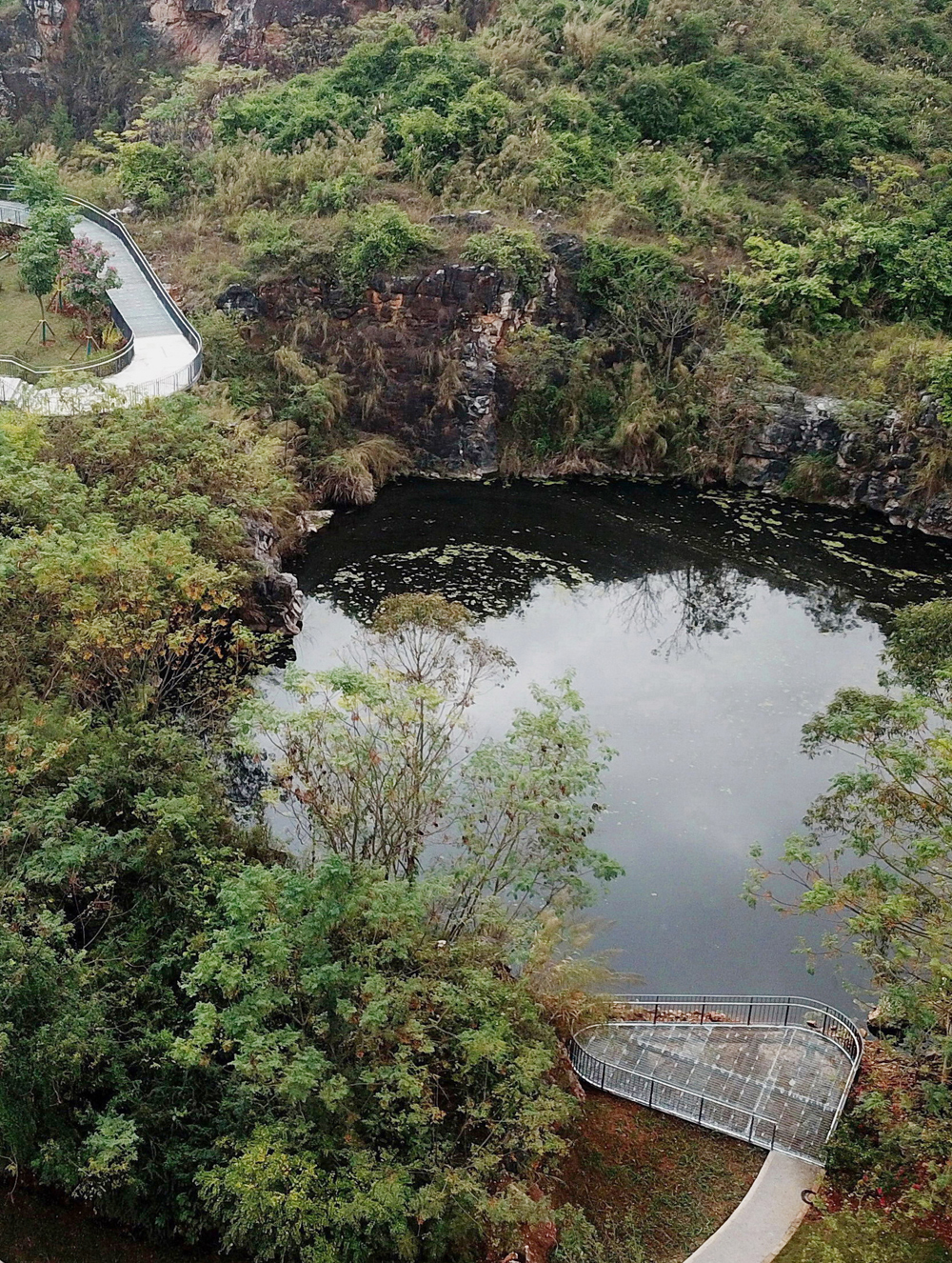
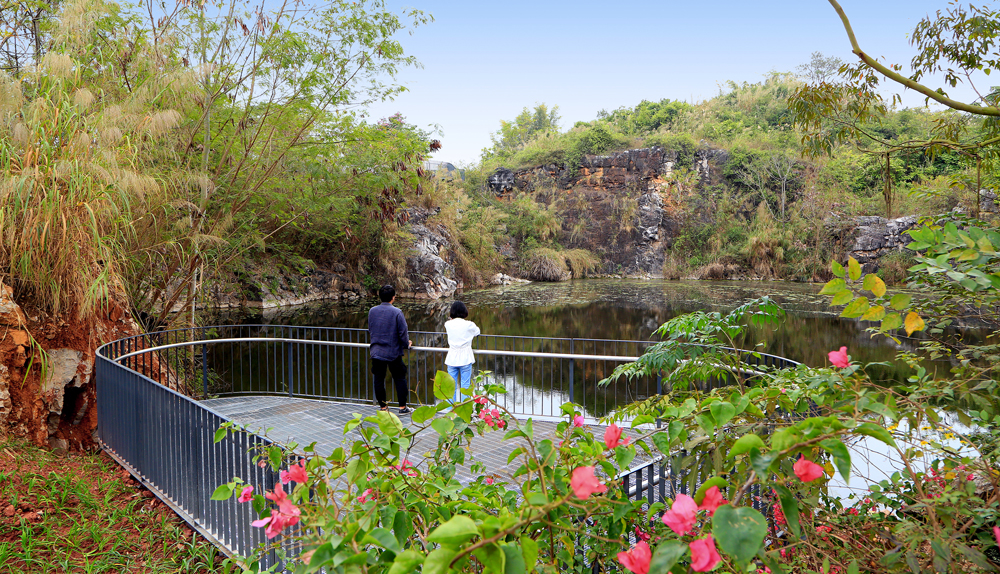
这是位于一座小山两翼的两个1000多平方米的小采石坑,一个较深,终年有水;另一个较浅,有季节性积水。因为废弃了若干年,两个坑的石缝里长出了各种乡土先锋植物,景观朴野自然。设计没有采用过多的人工干预,只在两个坑体中间未被开采的山坡上设置了一圈环形栈道,让游人在这里俯视两侧的采石坑,让人们了解在矿坑修复中自然的力量和作用。在西侧坑体边缘设了一个临水小平台,与山上的环形栈道相呼应。栈道和平台都采用钢格栅的材料,透光透水,不会影响场地自然植被的恢复。
Quarry No. 7 comprises of two small quarry pits located on two sides of a hill. Abandoned for years, a variety of native pioneer plants have grown out of cracks in the rocks, displaying a natural landscape. With only a few interventions, a ring-shaped walkway skirting the hillside between two pits and a small platform on the edge of the west pit are constructed. They affords visitors a wild view , which demonstrates natural forces and functions in the restoration of quarries. Both walkway and platform adopt steel grating that transmit light and water, preserving the natural vegetation on site.


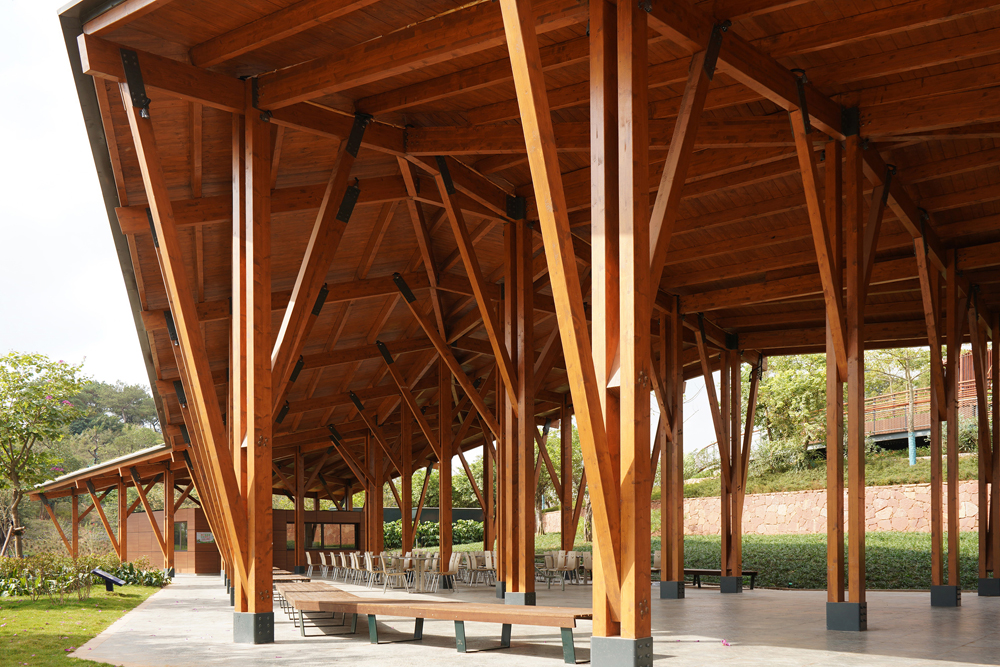
场地上原有一道水渠,是场地农业历史的见证。我们在设计中保留了水渠,将它作为该区域几个水面的补水水源,延续它原有的功能,并水渠上方架设高架步行桥,与相临的采石场花园的游览路径连接起来,形成该区域独特的立体游览体系。为了给游客提供一些基本服务,同时也展示园区生态修复的理念和方法,我们在采石场区域设计了一个600m²的信息亭。木结构的建筑呼应了当地乡土建筑的形式。
An existing aqueduct runs across the site, transporting water from nearby spring to surrounding villages and farms. As a witness of site’s agricultural history, it is well-preserved for irrigation water supply of the area, retaining its original function. Above the aqueduct is a pedestrian bridge that connects to the paths toward the adjacent quarry gardens, creating a unique three-dimensional tour system in this area. A 600m2 pavilion provides various tourist services such as sales, rest, shuttle bus ticketing, etc., and also showcases the history and eco-restoration processes and methods of the quarry gardens.
通过契合场地地貌和景观特征的设计,7个岩石破碎、荒凉的采石场转变成为了园林博览会上独特的系列花园,展现了采石场生态修复的可能性和景观艺术的不同维度。它们所展现出来的思想和方法,不仅仅在采石场修复项目中、并且在更广泛的景观实践中具有示范的价值。
With the design well-fitted with its original landform and landscape features, seven dilapidated and desolate quarries have undergone a fascinating transformation into a series of unique gardens. They demonstrate the promising possibilities and showcase to the public the diversified methods of quarry eco-restoration as well as the multiple dimensions of landscape art.
主持设计师:王向荣、林箐
设计团队:李倞、张诗阳、刘通、李洋、张铭然、郑小东、华锐、韩宇、许璐、金佳鑫、赵真真、王譞、常弘、杜红娟、崔庆伟、张雪葳、王越、李恒、王晞月、谭立、张雨生、满媛、李雯
Leader designer:Wang Xiangrong、Lin Qing
Team:Li Liang、Zhang Shiyang、Liu Tong、Li Yang、Zhang Mingran、Zheng Xiaodong、Hua Rui、Han Yu、Xu Lu、Jin Jiaxin、Zhao Zhenzhen、Wang Xuan、Chang Hong、Du Hongjuan、Cui Qingwei、Zhang Xuewei、Wang Yue、Li Heng、Wang Xiyue、Tan Li、Zhang Yusheng、Man Yuan、Li Wen